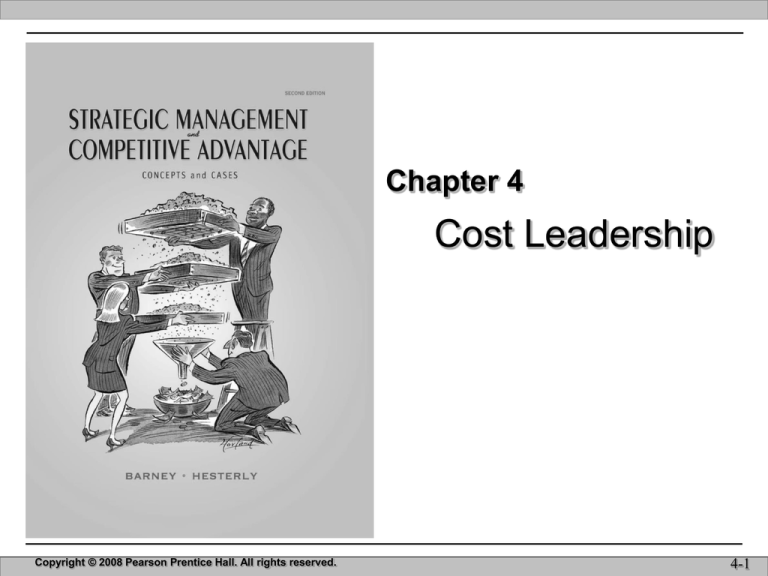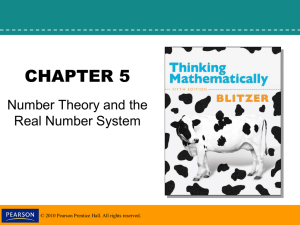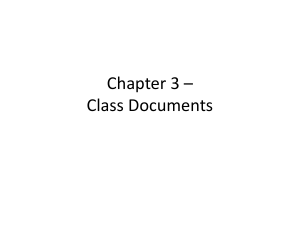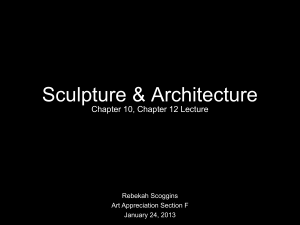
Chapter 4
Cost Leadership
Copyright © 2008 Pearson Prentice Hall. All rights reserved.
4-1
Cost
Cost Leadership
Leadership
The Strategic Management Process
External
Analysis
Mission
Strategic
Choice
Objectives
Strategy
Implementation
Competitive
Advantage
Internal
Analysis
Business Level
Strategy
How to Position a
Business
in the Market?
Copyright © 2008 Pearson Prentice Hall. All rights reserved.
Corporate Level
Strategy
Which Businesses
to Enter?
4-2
2
Cost
Cost Leadership
Leadership
Business Level Strategies
Two Generic Business Level Strategies
Cost Leadership:
• generate economic value by having lower costs
than competitors
Example: Wal-Mart
Product Differentiation:
• generate economic value by offering a product
that customers prefer over competitors’ product
Example: Harley-Davidson
Copyright © 2008 Pearson Prentice Hall. All rights reserved.
4-3
3
Cost
Cost Leadership
Leadership
Why Cost Leadership Matters
Competitive Market
ATCind
ATCff
P
Above Normal
Economic
Returns
Copyright © 2008 Pearson Prentice Hall. All rights reserved.
D
Q
4-4
4
Cost
Cost Leadership
Leadership
Understanding Cost Advantage
Managers need to understand who has
the cost advantage in their market
• it could be the focal firm
• develop a strategy to exploit the advantage
• it could be a competitor
• develop a strategy to either capture the
advantage or compete on some other basis
Copyright © 2008 Pearson Prentice Hall. All rights reserved.
4-5
5
Cost
Cost Leadership
Leadership
Sources of Cost Advantage
Economies of Scale
• average cost per unit falls as quantity increases
-until the minimum efficient scale is reached
• are a cost advantage because competitors may
not be able to match the scale because of capital
requirements (barrier to entry)
• international expansion may allow a firm to have
enough sales to justify investing in additional
capacity to capture economies of scale
Copyright © 2008 Pearson Prentice Hall. All rights reserved.
4-6
6
Cost
Cost Leadership
Leadership
Sources of Cost Advantage
Diseconomies of Scale
• are an advantage for those who do not have
diseconomies of scale
• occur when firms become too large and bureaucratic
• are a risk of international expansion
Example: Nucor Steel
Copyright © 2008 Pearson Prentice Hall. All rights reserved.
4-7
7
Cost
Cost Leadership
Leadership
Sources of Cost Advantage
Learning Curve Economies
• a firm gets more efficient at a process with experience
• the more complicated/technical the process,
the greater the experience advantage
• international expansion may propel a firm down the
experience curve because of higher volumes
Example: Fuel Injectors
Copyright © 2008 Pearson Prentice Hall. All rights reserved.
4-8
8
Cost
Cost Leadership
Leadership
Sources of Cost Advantage
Differential Low-Cost Access to Productive Inputs
• may result from:
• history—being in the right place at the right time
• being first into a market—esp. foreign markets
• natural endowment—owning a mineral deposit
• locking up a source—buying all of its output
Example: Quantity Carpet Buys
Copyright © 2008 Pearson Prentice Hall. All rights reserved.
4-9
9
Cost
Cost Leadership
Leadership
Sources of Cost Advantage
Technology Independent of Scale
• may allow small firms to become cost competitive
• advantage typically accrues to the ‘owner’ of the
technology—may or may not be the ones who actually
use the technology
• size of the advantage depends both on how valuable
and protectable the technology is
Example: Vegetable Inspection
Copyright © 2008 Pearson Prentice Hall. All rights reserved.
4-10
10
Cost
Cost Leadership
Leadership
Sources of Cost Advantage
Policy Choices
• firms get to choose how they will serve the market
• we’ll offer level of quality that is inexpensive to
produce
• firms can make policy choices that give people
incentives to reduce cost at every opportunity
Example: Southwest Airlines
Copyright © 2008 Pearson Prentice Hall. All rights reserved.
4-11
11
Cost
Cost Leadership
Leadership
Cost Leadership & Competitive Advantage
A source of cost advantage will lead to
competitive advantage if that source is:
• Valuable
• Rare
• Costly to Imitate
• Organized (Implemented Appropriately)
Copyright © 2008 Pearson Prentice Hall. All rights reserved.
4-12
12
Cost
Cost Leadership
Leadership
Value of a Cost Advantage
Entry
Buyers
• lowers incentives
for buyers to
vertically
integrate
• increases capital
requirements
for entrants
Rivalry
Substitutes
• competitors rationally
avoid price competition
• limits
attractiveness
of substitutes
Copyright © 2008 Pearson Prentice Hall. All rights reserved.
Suppliers
• increases
importance of the
focal firm to the
supplier
4-13
13
Cost
Cost Leadership
Leadership
Rareness of a Cost Advantage
The rareness of a source of cost advantage
depends heavily on the industry life cycle:
Generally…
Emerging
Mature
Not Rare
Rare
Diseconomies of Scale
Rare
Rare
Learning Curve Economies
Rare
Not Rare
Differential Input Access
Rare
Rare
Technology
Rare
Not Rare
Policy Choices
Rare
Rare
Economies of Scale
Copyright © 2008 Pearson Prentice Hall. All rights reserved.
4-14
14
Cost
Cost Leadership
Leadership
Imitability of Sources of Cost Advantage
Conditions largely determine if a source of cost
advantage will be costly to imitate
Low Cost Conditions
Unbalanced Industry Capacity and Demand
Non-Proprietary Technology
Highly Observable Technology
Transactional Exchange
(A cost advantage can be easily imitated)
Copyright © 2008 Pearson Prentice Hall. All rights reserved.
4-15
15
Cost
Cost Leadership
Leadership
Imitability of Sources of Cost Advantage
High Cost Conditions
Balanced Industry Capacity and Demand
Path Dependence (Historical Uniqueness)
Protected Technology
Highly Unobservable Technology (Causal Ambiguity)
Relational Exchange (Social Complexity)
(A cost advantage cannot be easily imitated)
Copyright © 2008 Pearson Prentice Hall. All rights reserved.
4-16
16
Cost
Cost Leadership
Leadership
Implementing a Cost Leadership Strategy
A strategy is only as good as its implementation
Strategy is implemented through organizational
structure and control:
• structure: 1) the division of management
responsibilities, and 2) the establishment of
reporting relationships
• control: policies intended to influence behavior—align
the interests of the individual with the interests of the
organization
Copyright © 2008 Pearson Prentice Hall. All rights reserved.
4-17
17
Cost
Cost Leadership
Leadership
Organizational Structure
Three Organizational Structures
Simple
Functional
Multi-Divisional
Copyright © 2008 Pearson Prentice Hall. All rights reserved.
4-18
18
Cost
Cost Leadership
Leadership
Organizational Structure
Simple Structure
Owner / Manager
• Owner/Manager makes all major decisions
directly and monitors all activities
• difficult to maintain this structure as the firm
grows in size and complexity
Copyright © 2008 Pearson Prentice Hall. All rights reserved.
4-19
19
Cost
Cost Leadership
Leadership
Organizational Structure
Functional Structure (U-Form: Unitary)
• divides management responsibilities by function
• marketing
• procurement
• HR
• finance
• production
• logistics
• accounting
• R&D
• etc.
• CEO is the only executive with enterprise-wide
perspective
• CEO is responsible for strategy & coordination
of functions
Copyright © 2008 Pearson Prentice Hall. All rights reserved.
4-20
20
Cost
Cost Leadership
Leadership
Organizational Structure
Functional Structure
Chief Executive Officer
Finance
Accounting
Production
Copyright © 2008 Pearson Prentice Hall. All rights reserved.
Human
Resources
Marketing
R&D
4-21
21
Cost
Cost Leadership
Leadership
Organizational Structure
Multi-Divisional Structure (M-Form)
• functions are replicated in each division as appropriate
• this structure makes sense when the firm is involved
in more than one business or has grown large enough
to justify geographic divisions
• CEO has strategic responsibility with the help of
vice presidents, etc.—information is filtered through layers
• CEO balances coordination & competition among
divisions
Copyright © 2008 Pearson Prentice Hall. All rights reserved.
4-22
22
Cost
Cost Leadership
Leadership
Organizational Structure
Multi-Divisional Structure (M-Form)
Chief Executive Officer
Corporate
R&D
Corporate
Finance
Production
Marketing
Copyright © 2008 Pearson Prentice Hall. All rights reserved.
Corporate
Human
Resources
Corporate
Marketing
Division
Division
Finance
Strategic
Planning
R&D
Division
Accounting
Human
Resources
4-23
23
Cost
Cost Leadership
Leadership
Organizational Structure
The Functional Structure and Cost Leadership
• specialization within functions facilitates cost reduction
• CEO can use this structure to:
• ensure best cost reduction practices are
shared among divisions
• allow and encourage decision-making by those
who are in the best positions to do so—those
close to decisions
• ensure that functions are coordinating efforts in
pursuit of a common strategy
Copyright © 2008 Pearson Prentice Hall. All rights reserved.
4-24
24
Cost
Cost Leadership
Leadership
Organizational Controls
Policies intended to influence behavior by aligning
the interests of the individual with the interests of
the organization
Management Controls
Formal
• budgeting policies
Informal
• culture
• credit policies
• attitudes
• spending policies
• leadership styles
• travel policies
• purchasing policies
Copyright © 2008 Pearson Prentice Hall. All rights reserved.
4-25
25
Cost
Cost Leadership
Leadership
Organizational Controls
Compensation Policies
• stock options
• bonuses based on:
• cost reduction
• non-monetary awards
• vacations
• parking places
• office decor
• financial performance
Compensation Policies Should Reinforce
Formal and Informal Management Controls
Copyright © 2008 Pearson Prentice Hall. All rights reserved.
4-26
26
Cost
Cost Leadership
Leadership
Organizational Controls
Organizational Controls and Cost Leadership
• management controls and compensation
policies can be focused on cost reduction
• supply contracts that stipulate cost reductions
over time
• tight credit policies
• austere travel policies (e.g., no first class)
• bonuses tied to cost reduction targets
Example: Wal-Mart & Southwest Airlines
Copyright © 2008 Pearson Prentice Hall. All rights reserved.
4-27
27
Cost
Cost Leadership
Leadership
Summary
Business Level Strategy
Cost Leadership
Product Differentiation
Cost Advantages
Economies of Scale
Competitive Advantage
Depends on Meeting
VRIO Criteria
Diseconomies of Scale
Learning Curve Economies
Differential Input Access
Emphasis on
Organization
(Implementation)
Technology
Policy Choices
Copyright © 2008 Pearson Prentice Hall. All rights reserved.
Structure &
Control
4-28
28







